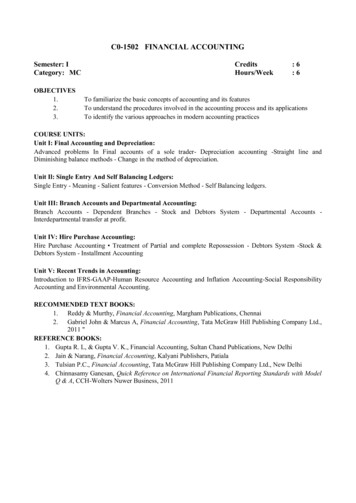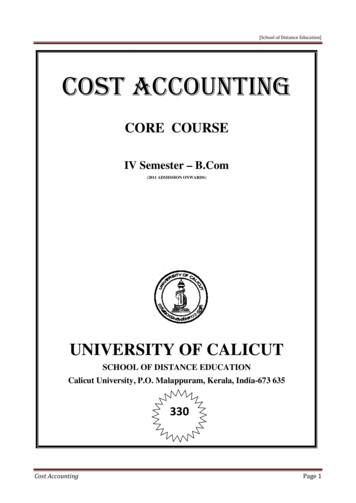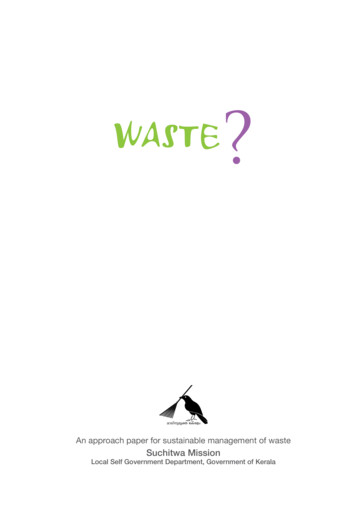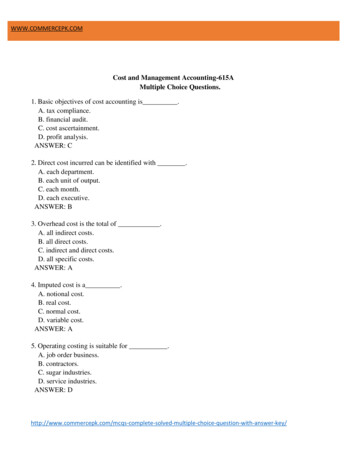
Transcription
Introduction to AccountingOLEARNING OBJECTIVESAfter studying this chapteryou will be able to: state the meaning andneed of accounting; discuss accounting asa source of information ; identify the internaland external users ofaccounting information; explain the objectivesof accounting; describe the role ofaccounting; explain the basic termsused in accounting.1ver the centuries, accounting has remainedconfined to the financial record-keepingfunctions of the accountant. But, today’s rapidlychanging business environment has forced theaccountants to reassess their roles and functionsboth within the organisation and the society. Therole of an accountant has now shifted from that ofa mere recorder of transactions to that of themember providing relevant information to thedecision-making team. Broadly speaking,accounting today is much more than just bookkeeping and the preparation of financial reports.Accountants are now capable of working in excitingnew growth areas such as: forensic accounting(solving crimes such as computer hacking and thetheft of large amounts of money on the internet); ecommerce (designing web-based payment system);financial planning, environmental accounting, etc.This realisation came due to the fact that accountingis capable of providing the kind of information thatmanagers and other interested persons need inorder to make better decisions. This aspect ofaccounting gradually assumed so much importancethat it has now been raised to the level of aninformation system. As an information system, itcollects data and communicates economicinformation about the organisation to a wide varietyof users whose decisions and actions are related toits per for mance. This introductory chaptertherefore, deals with the nature, need and scope ofaccounting in this context.2018-19
21.1AccountancyMeaning of AccountingIn 1941, The American Institute of Certified Public Accountants (AICPA) haddefined accounting as the art of recording, classifying, and summarising in asignificant manner and in terms of money, transactions and events whichare, in part at least, of financial character, and interpreting the results thereof’.With greater economic development resulting in changing role of accounting,its scope, became broader. In 1966, the American Accounting Association(AAA) defined accounting as ‘the process of identifying, measuring andcommunicating economic information to permit informed judgments anddecisions by users of information’.Fig. 1.1 : Showing the process of accountingIn 1970, the Accounting Principles Board of AICPA also emphasised thatthe function of accounting is to provide quantitative information, primarilyfinancial in nature, about economic entities, that is intended to be useful inmaking economic decisions.Accounting can therefore be defined as the process of identifying,measuring, recording and communicating the required information relatingto the economic events of an organisation to the interested users of such2018-19
Introduction to Accounting3information. In order to appreciate the exact nature of accounting, we mustunderstand the following relevant aspects of the definition: Economic Events Identification, Measurement, Recording and Communication Organisation Interested Users of InformationBox 1History and Development of AccountingAccounting enjoys a remarkable heritage. The history of accounting is as old ascivilisation. The seeds of accounting were most likely first sown in Babylonia andEgypt around 4000 B.C. who recorded transactions of payment of wages and taxeson clay tablets. Historical evidences reveal that Egyptians used some form ofaccounting for their treasuries where gold and other valuables were kept. The inchargeof treasuries had to send day wise reports to their superiors known as Wazirs (theprime minister) and from there month wise reports were sent to kings. Babylonia,known as the city of commerce, used accounting for business to uncover lossestaken place due to frauds and lack of efficiency. In Greece, accounting was used forapportioning the revenues received among treasuries, maintaining total receipts,total payments and balance of government financial transactions. Romans usedmemorandum or daybook where in receipts and payments were recorded andwherefrom they were posted to ledgers on monthly basis. (700 B.C to 400 A.D).China used sophisticated form of government accounting as early as 2000 B.C.Accounting practices in India could be traced back to a period when twenty threecenturies ago, Kautilya, a minister in Chandragupta’s kingdom wrote a book namedArthashasthra, which also described how accounting records had to be maintained.Luca Pacioli’s, a Franciscan friar (merchant class), book Summa deArithmetica, Geometria, Proportion at Proportionality (Review of Arithmetic and Geometricproportions) in Venice (1494) is considered as the first book on double entry bookkeeping. A portion of this book contains knowledge of business and book-keeping.However, Pacioli did not claim that he was the inventor of double entry book-keepingbut spread the knowledge of it. It shows that he probably relied on then–currentbook-keeping manuals as the basis for his masterpiece. In his book, he used thepresent day popular terms of accounting Debit (Dr.) and Credit (Cr.). These were theconcepts used in Italian terminology. Debit comes from the Italian debito which comesfrom the Latin debita and debeo which means owed to the proprietor. Credit comesfrom the Italian credito which comes from the Latin ‘credo’ which means trust or belief(in the proprietor or owed by the proprietor. In explaining double entry system, Pacioliwrote that ‘All entries have to be double entries, that is if you make one creditor, youmust make some debtor’. He also stated that a merchants responsibility include togive glory to God in their enterprises, to be ethical in all business activities and toearn a profit. He discussed the details of memorandum, journal, ledger and specialisedaccounting procedures.2018-19
4Accountancy1.1.1 Economic EventsBusiness organisations involves economic events. An economic event is knownas a happening of consequence to a business organisation which consists oftransactions and which are measurable in monetary terms. For example,purchase of machinery, installing and keeping it ready for manufacturing isan event which comprises number of financial transactions such as buying amachine, transportation of machine, site preparation for installation of amachine, expenditure incurred on its installation and trial runs. Thus,accounting identifies bunch of transactions relating to an economic event. Ifan event involves transactions between an outsider and an organisation, theseare known as external events. The following are the examples of suchtransactions: Sale of merchandise to the customers. Rendering services to the customers by ABC Limited. Purchase of materials from suppliers. Payment of monthly rent to the landlord.An internal event is an economic event that occurs entirely between theinternal wings of an enterprise, e.g., supply of raw material or components bythe stores department to the manufacturing department, payment of wagesto the employees, etc.1.1.2 Identification, Measurement, Recording and CommunicationIdentification : It means determining what transactions to record, i.e., to identityevents which are to be recorded. It involves observing activities and selectingthose events that are of considered financial character and relate to theorganisation. The business transactions and other economic events thereforeare evaluated for deciding whether it has to be recorded in books of account.For example, the value of human resources, changes in managerial policiesor appointment of personnel are important but none of these are recorded inbooks of account. However, when a company makes a sale or purchase, whetheron cash or credit, or pays salary it is recorded in the books of account.Measurement : It means quantification (including estimates) of businesstransactions into financial terms by using monetary unit, viz. rupees andpaise as a measuring unit. If an event cannot be quantified in monetaryterms, it is not considered for recording in financial accounts. That is whyimportant items like the appointment of a new managing director, signing ofcontracts or changes in personnel are not shown in the books of accounts.Recording : Once the economic events are identified and measured in financialterms, these are recorded in books of account in monetary terms and in achronological order. Recording is done in a manner that the necessary financial2018-19
Introduction to Accounting5information is summarised as per well-established practice and is made availableas and when required.Communication : The economic events are identified, measured and recordedin order that the pertinent information is generated and communicated in acertain form to management and other internal and external users. Theinformation is regularly communicated through accounting reports. Thesereports provide information that are useful to a variety of users who have aninterest in assessing the financial performance and the position of anenterprise, planning and controlling business activities and making necessarydecisions from time to time. The accounting information system should bedesigned in such a way that the right information is communicated to theright person at the right time. Reports can be daily, weekly, monthly, orquarterly, depending upon the needs of the users. An important element inthe communication process is the accountant’s ability and efficiency inpresenting the relevant information.1.1.3 OrganisationOrganisation refers to a business enterprise, whether for profit or not-forprofit motive. Depending upon the size of activities and level of businessoperation, it can be a sole-proprietory concern, partnership firm, cooperativesociety, company, local authority, municipal corporation or any otherassociation of persons.1.1.4 Interested Users of InformationAccounting is a means by which necessary financial information aboutbusiness enterprise is communicated and is also called the language ofbusiness. Many users need financial information in order to make importantdecisions. These users can be divided into two broad categories: internal usersand external users. Internal users include: Chief Executive, Financial Officer,Vice President, Business Unit Managers, Plant Managers, Store Managers,Line Supervisors, etc. External users include: present and potential Investors(shareholders), Creditors (Banks and other Financial Institutions, Debentureholders and other Lenders), Tax Authorities, Regulatory Agencies (Departmentof Company Affairs, Registrar of Companies, Securities Exchange Board ofIndia, Labour Unions, Trade Associations, Stock Exchange and Customers,etc. Since the primary function of accounting is to provide useful informationfor decision-making, it is a means to an end, with the end being the decisionthat is helped by the availability of accounting information. You will studyabout the types of accounting information and its users later in this chapter.2018-19
6AccountancyBox2Why do the Users Want Accounting Information? The owners/shareholders use them to see if they are getting a satisfactory returnon their investment, and to assess the financial health of their company/business. The directors/managers use them for making both internal and externalcomparisons in their attempts to evaluate the performance. They may comparethe financial analysis of their company with the industry figures in order toascertain the company’s strengths and weaknesses. Management is alsoconcerned with ensuring that the money invested in the company/organisationis generating an adequate return and that the company/organisation is able topay its debts and remain solvent. The creditors (lenders) want to know if they are likely to get paid and lookparticularly at liquidity, which is the ability of the company/organisation to payits debts as they become due. The prospective investors use them to assess whether or not to invest theirmoney in the company/organisation. The government and regulatory agencies such as Registrar of companies, Customdepartments IRDA, RBI, etc. require information for the payment of various taxessuch as Value Added Tax (VAT), Income Tax (IT), Customs and Excise duties forprotecting the interests of investors, creditors(lenders), and also to satisfy thelegal obligations imposed by The Companies Act 2013 and SEBI from time-totime.1.2Accounting as a Source of InformationAs discussed earlier, accounting is a definite processes of interlinked activities,(refer figure 1.1) that begins with the identification of transactions and endswith the preparation of financial statements. Every step in the process ofaccounting generates information. Generation of information is not an endin itself. It is a means to facilitate the dissemination of information amongdifferent user groups. Such information enables the interested parties totake appropriate decisions. Therefore, dissemination of information is anessential function of accounting. To be useful, the accounting information shouldensure to: provide information for making economic decisions; serve the users who rely on financial statements as their principal sourceof information; provide information useful for predicting and evaluating the amount,timing and uncertainty of potential cash-flows; provide information for judging management’s ability to utilise resourceseffectively in meeting goals;2018-19
Introduction to Accounting7 provide factual and interpretative information by disclosing underlyingassumptions on matters subject to interpretation, evaluation, prediction,or estimation; and provide information on activities affecting the society.Test Your Understanding - IComplete the following sentences with appropriate words:(a) Information in financial reports is based on .(b) Internal users are the . of the business entity.(c) A . would most likely use an entities financial report to determinewhether or not the business entity is eligible for a loan.(d) The Internet has assisted in decreasing the . in issuing financialreports to users.(e) . users are groups outside the business entity, who uses theinformation to make decisions about the business entity.(f)Information is said to be relevent if it is .(g) The process of accounting starts with . and ends with .(h) Accounting measures the business transactions in terms of . units.(i)Identified and measured economic events should be recording in . order.The role of an accountant in generating accounting information is to observe,screen and recognise events and transactions to measure and process them,and thereby compile reports comprising accounting information that arecommunicated to the users. These are then interpreted, decoded and usedby management and other user groups. It must be ensured that the informationprovided is relevant, adequate and reliable for decision-making. The apparentlydivergent needs of internal and external users of accounting information haveresulted in the development of sub-disciplines within the accounting disciplinenamely, financial accounting, cost accounting and management accounting (referbox 3).Financial accounting assists keeping a systematic record of financialtransactions the preparation and presentation of financial reports in order toarrive at a measure of organisational success and financial soundness. Itrelates to the past period, serves the stewardship function and is monetary innature. It is primarily concerned with the provision of financial information toall stakeholders.Cost accounting assists in analysing the expenditure for ascertaining thecost of various products manufactured or services rendered by the firm and2018-19
8Accountancyfixation of prices thereof. It also helps in controlling the costs and providingnecessary costing information to management for decision-making.Management accounting deals with the provision of necessary accountinginformation to people within the organisation to enable them in decision-making,planning and controlling business operations. Management accounting drawsthe relevant information mainly from financial accounting and cost accountingwhich helps the management in budgeting, assessing profitability, taking pricingdecisions, capital expenditure decisions and so on. Besides, it generates otherinformation (quantitative and qualitative, financial and non-financial) whichrelates to the future and is relevant for decision-making in the organisation.Such information includes: sales forecast, cash flows, purchase requirement,manpower needs, environmental data about effects on air, water, land, naturalresources, flora, fauna, human health, social responsibilities, etc.As a result, the scope of accounting has become so vast, that new areaslike human resource accounting, social accounting, responsibility accountinghave also gained prominance.Let’s Do ItMany People in today’s society think of an accountant as simply a glorified bookkeeper. But the role of an accountant is continually changing. Discuss in theclassroom what really the role of accounting is?1.2.1 Qualitative Characteristics of Accounting InformationQualitative characteristics are the attributes of accounting information whichtend to enhance its understandability and usefulness. In order to assesswhether accounting information is decision useful, it must possess thecharacteristics of reliability, relevance, understandability and comparability.ReliabilityReliability means the users must be able to depend on the information. Thereliability of accounting information is determined by the degree ofcorrespondence between what the information conveys about the transactionsor events that have occurred, measured and displayed. A reliable informationshould be free from error and bias and faithfully represents what it is meantto represent. To ensure reliability, the information disclosed must be credible,verifiable by independent parties use the same method of measuring, and beneutral and faithful (refer figure 1.3).2018-19
Introduction to Accounting9Box3Branches of AccountingThe economic development and technological advancements have resulted in anincrease in the scale of operations and the advent of the company form of businessorganisation. This has made the management function more and more complex andincreased the importance of accounting information. This gave rise to special branchesof accounting. These are briefly explained below :Financial accounting : The purpose of this branch of accounting is to keep arecord of all financial transactions so that:(a) the profit earned or loss sustained by the business during an accounting periodcan be worked out,(b) the financial position of the business as at the end of the accounting periodcan be ascertained, and(c)the financial information required by the management and other interestedparties can be provided.Cost Accounting : The purpose of cost accounting is to analyse the expenditure soas to ascertain the cost of various products manufactured by the firm and fix theprices. It also helps in controlling the costs and providing necessary costinginformation to management for decision-making.Management Accounting : The purpose of management accounting is to assist themanagement in taking rational policy decisions and to evaluate the impact of itsdecisons and actions.RelevanceTo be relevant, information must be available in time, must help in predictionand feedback, and must influence the decisions of users by :(a)helping them form prediction about the outcomes of past, present orfuture events; and/or(b)confirming or correcting their past evaluations.UnderstandabilityUnderstandability means decision-makers must interpret accountinginformation in the same sense as it is prepared and conveyed to them. Thequalities that distinguish between good and bad communication in a messageare fundamental to the understandability of the message. A message is saidto be effectively communicated when it is interpreted by the receiver of themessage in the same sense in which the sender has sent. Accountants shouldpresent the comparable information in the most intenlligible manner withoutsacrificing relevance and reliability.2018-19
10AccountancyComparabilityIt is not sufficient that the financial information is relevant and reliable at aparticular time, in a particular circumstance or for a particular reporting entity.But it is equally important that the users of the general purpose financial reportsare able to compare various aspects of an entity over different time period andwith other entities. To be comparable, accounting reports must belong to acommon period and use common unit of measurement and format of reporting.Test Your Understanding - IIYou are a senior accountant of Ramona Enterprises Limited. What three steps wouldyou take to make your company’s financial statements understandable and decisionuseful?1. �—————————————2. �—————————————3. �—————————————[Hint : Refer to qualitative characteristics of accounting information]1.3Objectives of AccountingAs an information system, the basic objective of accounting is to provide usefulinformation to the interested group of users, both external and internal. Thenecessary information, particularly in case of external users, is provided inthe form of financial statements, viz., profit and loss account and balancesheet. Besides these, the management is provided with additional informationfrom time to time from the accounting records of business. Thus, the primaryobjectives of accounting include the following:1.3.1 Maintenance of Records of Business TransactionsAccounting is used for the maintenance of a systematic record of all financialtransactions in book of accounts. Even the most brilliant executive or managercannot accurately remember the numerous amount of varied transactionssuch as purchases, sales, receipts, payments, etc. that takes place in businesseveryday. Hence, a proper and complete records of all business transactionsare kept regularly. Moreover, the recorded information enables verifiabilityand acts as an evidence.1.3.2 Calculation of Profit and LossThe owners of business are keen to have an idea about the net results of theirbusiness operations periodically, i.e. whether the business has earned profits2018-19
Introduction to Accounting11Qualitative Characteristics of Accounting InformationDecision Makers(Users of Accounting Information)UnderstandabilityDecision ComparabilityFig. 1.3 : The qualitative characteristics of accounting informationor incurred losses. Thus, another objective of accounting is to ascertain theprofit earned or loss sustained by a business during an accounting periodwhich can be easily workout with help of record of incomes and expensesrelating to the business by preparing a profit or loss account for the period.Profit represents excess of revenue (income), over expenses. If the total revenueof a given period is Rs 6,00,000 and total expenses are Rs. 5,40,000 the profitwill be equal to Rs. 60,000(Rs. 6,00,000 – Rs. 5,40,000). If however, the totalexpenses exceed the total revenue, the difference reflects the loss.1.3.3 Depiction of Financial PositionAccounting also aims at ascertaining the financial position of the businessconcern in the form of its assets and liabilities at the end of every accountingperiod. A proper record of resources owned by business organisation (Assets)2018-19
12Accountancyand claims against such resources (Liabilities) facilitates the preparation of astatement known as balance sheet position statement.1.3.4Providing Accounting Information to its UsersThe accounting information generated by the accounting process iscommunicated in the form of reports, statements, graphs and charts to theusers who need it in different decision situations. As already stated, there aretwo main user groups, viz. internal users, mainly management, who needstimely information on cost of sales, profitability, etc. for planning, controllingand decision-making and external users who have limited authority, abilityand resources to obtain the necessary information and have to rely on financialstatements (Balance Sheet, Profit and Loss account). Primarily, the externalusers are interested in the following: Investors and potential investors-information on the risks and return oninvestment; Unions and employee groups-information on the stability, profitabilityand distribution of wealth within the business; Lenders and financial institutions-information on the creditworthiness ofthe company and its ability to repay loans and pay interest; Suppliers and creditors-information on whether amounts owed will berepaid when due, and on the continued existence of the business; Customers-information on the continued existence of the business andthus the probability of a continued supply of products, parts and aftersales service; Government and other regulators- information on the allocation ofresources and the compliance to regulations; Social responsibility groups, such as environmental groups-informationon the impact on environment and its protection; Competitors-information on the relative strengths and weaknesses of theircompetition and for comparative and benchmarking purposes. Whereasthe above categories of users share in the wealth of the company,competitors require the information mainly for strategic purposes.Test Your Understanding - IIIWhich stakeholder g roup would be most interested in(a) the VAT and other tax liabilities of the firm(b) the potential for pay awards and bouns deals(c) the ethical or environmental activities of the firm(d) whether the firm has a long-term future(e) profitability and share performance(f) the ability of the firm to carry on providing aservice or producing a product.2018-19
Introduction to Accounting1.413Role of AccountingFor centuries, the role of accounting has been changing with the changes ineconomic development and increasing societal demands. It describes andanalyses a mass of data of an enterprise through measurement, classificationand summarisation, and reduces those date into reports and statements, whichshow the financial condition and results of operations of that enterprise. Hence,it is regarded as a language of business. It also performs the service activity byproviding quantitative financial information that helps the users in various ways.Accounting as an information system collects and communicates economicinformation about an enterprise to a wide variety of interested parties. However,accounting information relates to the past transactions and is quantitative andfinancial in nature, it does not provide qualitative and non-financial information.These limitations of accounting must be kept in view while making use of theaccounting information.Test Your Understanding - IVTick the Correct Answer1. Which of the following is not a business transaction?a. Bought furniture of Rs.10,000 for businessb. Paid for salaries of employees Rs.5,000c. Paid sons fees from her personal bank account Rs.20,000d. Paid sons fees from the business Rs.2,0002. Deepti wants to buy a building for her business today. Which of the following is therelevant data for his decision?a. Similar business acquired the required building in 2000 for Rs. 10,00,000b. Building cost details of 2003c. Building cost details of 1998d. Similar building cost in August, 2005 Rs. 25,00,0003. Which is the last step of accounting as a process of information?a. Recording of data in the books of accountsb. Preparation of summaries in the form of financial statementsc. Communication of informationd. Analysis and interpretation of information4. Which qualitative characteristics of accounting information is reflected whenaccounting information is clearly presented?a. Understandabilityb. Relevancec. Comparabilityd. Reliability5. Use of common unit of measurement and common format of reporting promotes;a. Comparabilityb. Understandabilityc. Relevanced. Reliability2018-19
14AccountancyBox 4Different Roles of Accountingüüüüü1.5As a language – it is perceived as the language of business which is used tocommunicate information on enterprises;As a historical record- it is viewed as chronological record of financial transactionsof an organisation at actual amounts involved;As current economic reality- it is viewed as the means of determining the trueincome of an entity namely the change of wealth over time;As an information system – it is viewed as a process that links an informationsource (the accountant) to a set of receivers (external users) by means of a channelof communication;As a commodity- specialised information is viewed as a service which is in demandin society, with accountants being willing to and capable of providing it.Basic Terms in Accounting1.5.1 EntityEntity means a reality that has a definite individual existence. Business entitymeans a specifically identifiable business enterprise like Super Bazaar, HireJewellers, ITC Limited, etc. An accounting system is always devised for a specificbusiness entity (also called accounting entity).1.5.2TransactionA event involving some value between two or more entities. It can be a purchaseof goods, receipt of money, payment to a creditor, incurring expenses, etc. Itcan be a cash transaction or a credit transaction.1.5.3 AssetsAssets are economic resources of an enterprise that can be usefully expressedin monetary terms. Assets are items of value used by the business in itsoperations. For example, Super Bazar
Luca Pacioli's, a Franciscan friar (merchant class), book Summa de Arithmetica, Geometria, Pr oportion at Pr oportionality (Review of Arithmetic and Geometric proportions) in Venice (1494) is considered as the first book on double entry book-keeping. A portion of this book contains knowledge of business and book-keeping.











